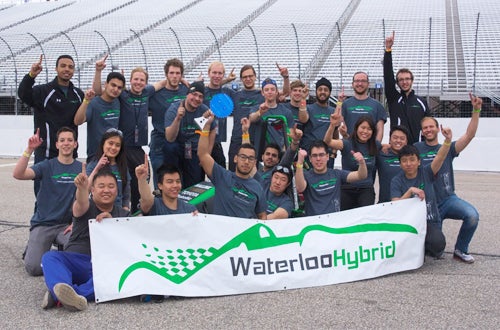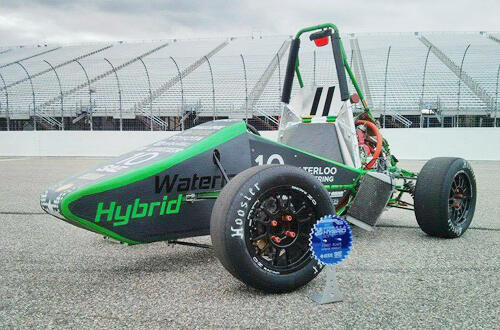
Waterloo’s Formula Hybrid race car takes first in international competition
Waterloo’s team defeats top universities like Princeton and Carnegie Mellon with custom battery system and lightweight materials

Waterloo’s team defeats top universities like Princeton and Carnegie Mellon with custom battery system and lightweight materials
By Carol Truemner Faculty of Engineering
The University of Waterloo’s Formula Hybrid race car took first place overall and set a new record at the annual Formula Hybrid International Competition this year. Unique design elements that included lighter materials and a more powerful battery system helped the Waterloo car edge out vehicles from other top universities.
“The team worked incredibly hard over the past four months to get the car ready,” says Faculty co-advisor Andrew Trivett, a mechanical and mechatronics engineering professor. “It’s one thing to design a car, but the students have shown they can turn innovative ideas into practical hardware.”
More than 27 teams, from as far away as Turkey and India, competed at the New Hampshire Motor Speedway. The annual competition, part of the Institute of Electrical and Electronics Engineers (IEEE) and Society of Automotive Engineers (SAE) Collegiate Design Series, challenges university students to design an open-wheel, single-seat, electric or hybrid-electric race car.
Besides taking the top award, Waterloo came first in the competition’s autocross event and the endurance category by setting a new all-time record of 33 laps.
Waterloo’s Formula Hybrid team is based in Engineering 5’s Sedra Student Design Centre that houses more than 20 student design teams.
"The main goal of the team members was to make their vehicle robust so that it could go through all the tests without any issues,” says Faculty advisor Amir Khajepour, a Waterloo mechanical and mechatronics engineering professor.
What propelled Waterloo’s race car to victory? Rishi Chatterjee, business lead for the team, says it was the hard work of the dedicated team members who were knowledgeable about the vehicle. “We knew how to go about sourcing solutions to new and existing problems,” says Chatterjee, a second year mechanical engineering student.

One of those problems was the race car’s electrical system. It was completely redesigned from the ground up after reliability issues during past competitions. “Our electrical team is what provided us with cutting-edge features, such as a custom-battery management system, and new vehicle and driver control units,” explains Chatterjee.
“Complementing those design changes, our mechanical team implemented various weight reduction techniques in components throughout the vehicle.”
Weight was decreased through innovative designs, such as a carbon fiber accumulator enclosure and a new lightweight differential designed by members Ping Cheng Zhang and Jacob Van Dorp as part of their fourth-year mechanical engineering Capstone Design project. The weight reductions allowed for more batteries to be added, which in turn increased the vehicle’s power output and efficiency.
Fueled by their recent victory, the team’s 38 members are already thinking about next year’s race car.
“The focus for 2016 will be design and ultimately implementing state-of-the-art systems such as in-hub motors, custom motor controllers, a larger capacity battery pack and a more refined vehicle,” Chatterjee says.

Read more
Waterloo celebrates its connection to the latest group of up-and-coming entrepreneurs

Read more
The Waterloo student team building the world’s first functional pneumatic hyperloop levitation system will share major milestone

Read more
Matt Rose learned how to bounce back from failure while building a prize-winning electric car in high school
Read
Engineering stories
Visit
Waterloo Engineering home
Contact
Waterloo Engineering
The University of Waterloo acknowledges that much of our work takes place on the traditional territory of the Neutral, Anishinaabeg, and Haudenosaunee peoples. Our main campus is situated on the Haldimand Tract, the land granted to the Six Nations that includes six miles on each side of the Grand River. Our active work toward reconciliation takes place across our campuses through research, learning, teaching, and community building, and is co-ordinated within the Office of Indigenous Relations.